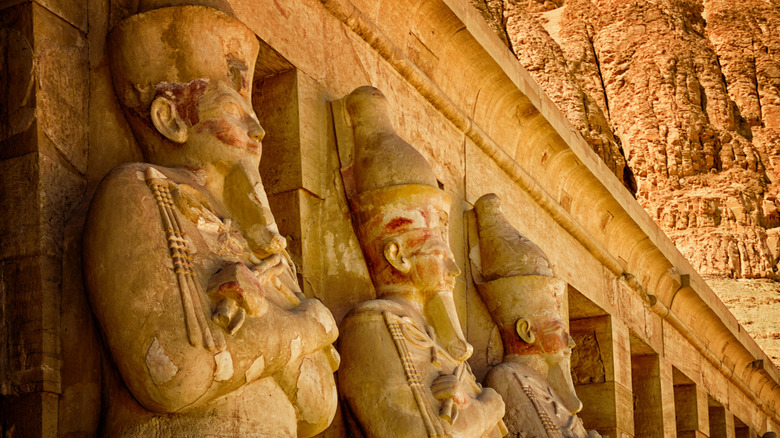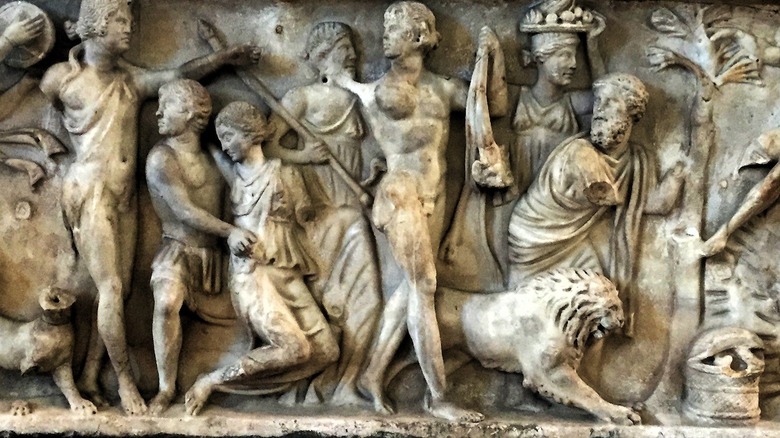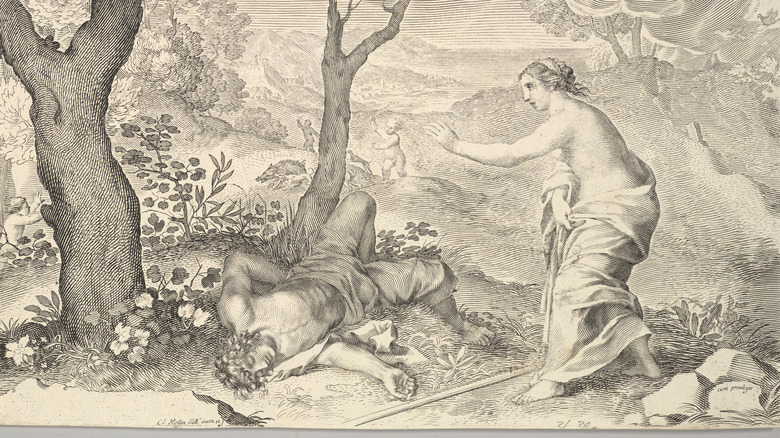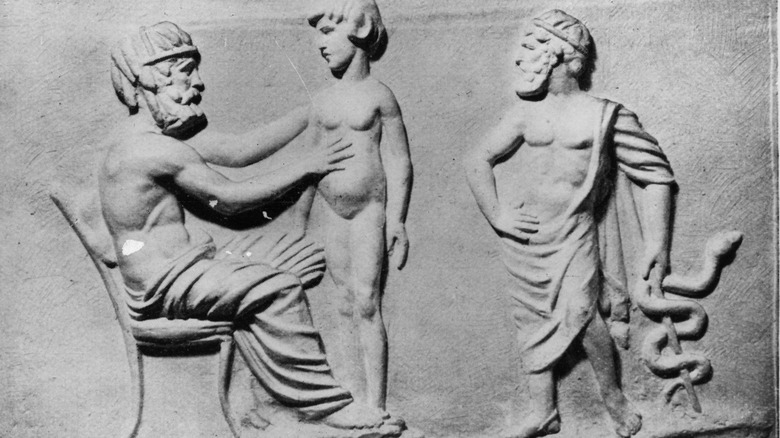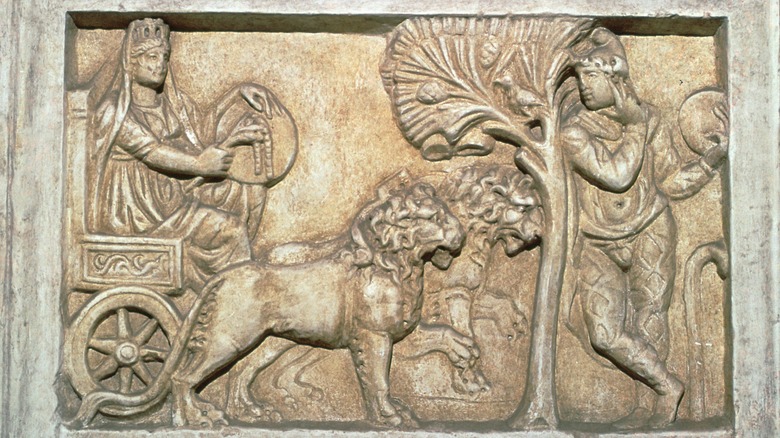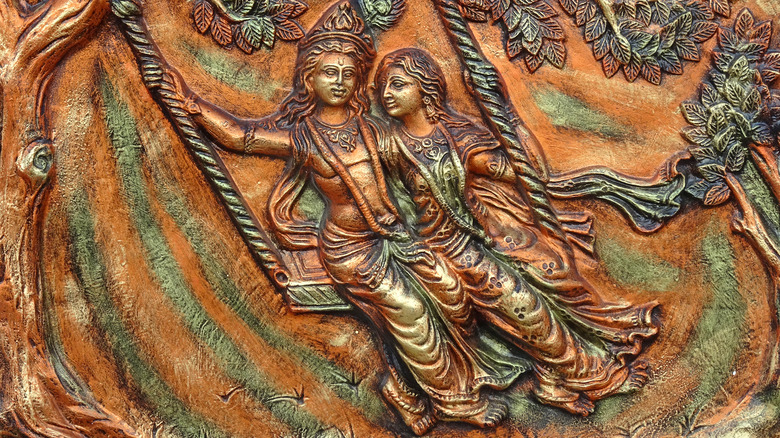The Truth About Mythological Figures Similar To Jesus
"All beings are in Me, but I am not in them ... I am the father of this universe ... the goal, the sustainer, the master, the witness, the abode, the refuge and the most dear friend ... Those who worship Me will live with Me."
To the world's 1 billion-plus Christians, this quote might sound oddly similar to a number of Jesus' statements from the Bible, outlined and cross-referenced on Bible Hub. But no, that quote is from Krishna from the sacred Hindu text, the Bhagavad Gita. The 700-line excerpt from the Mahabharata — a 100,000-stanza collection of tales of gods and humans — was first compiled in about A.D. 350 CE, as Brown University dates it. The quote embodies Krishna's theological essence as a savior-redeemer figure and incarnation of Vishnu, a theme and aspect of the divine that resembles not only Jesus but numerous mythological narratives across the globe.
Investigations of similarities between myths fall into the field of "comparative mythology." We don't define "myths" as merely fantastical stories once believed as religion by ancient civilizations, like tales of Zeus, Gilgamesh, or Shango. They're frameworks of meaning-making narratives that entire societies tell themselves to make sense of their world, past or present. And broad-stroke, allegorical elements of Jesus' story — virgin birth, incarnate god, redeemer of humanity, trial of pain and death, resurrection to life in a few form, and so on — tend to repeat themselves across varying cultures. Notably, fragments of these elements are visible in numerous figures: Osiris, Dionysus, Adonis, Asclepius, Attis, and more.
Themes and tales repeated for millennia
A couple of disclaimers: When discussing this topic, especially as it relates to active religions — Christianity, Islam, Hinduism, etc. — it's way too easy to wade into crazed polemics or frothing recriminations. Many online sources inherently adopt an antagonistic, defensive stance towards even the bare-bones notion of similarities between Jesus' story and other historical-mythological figures, seeking to frame causality to point to Jesus first, chronologically. Elsewhere, some assume that such "atheist nonsense," as News 24 puts it, constitutes an attempt to debunk or de-substantiate someone's cherished beliefs. It does not.
Hostility and ego prevent us from investigating what it is about the human condition that leads so many different peoples to find meaning in stories with similar elements. And by "similar elements," we don't mean plot points from the Biblical nativity scene in Matthew 1:18-2:23 like "Wise Man Number Three Gave Myrrh." We mean people the world over, for literally thousands of years, have framed their lives in terms of right vs. wrong, light vs. dark, order vs. disorder, needing rescue, being born inadequate, seeking reconnection to the divine, seeking to surpass the mundane, wanting to avoid pain, desiring to never die, and so forth. These core facets of human existence live and breathe through not only the story of Jesus' life and death, but many others.
So, substantiating theological truth? Not the point of this article. Secularly sticking to texts to identify commonalities that reveal universal human concerns? Definitely the point.
Osiris died and was resurrected as a judge of the dead
One of the earliest figures from myth that resembles Jesus is Osiris, the Egyptian judge of the dead. Osiris didn't start weighing human deeds against a feather, though. Osiris passed from the living to the dead and back to the living, resurrected, and therefore became capable of pronouncing judgment on others who do the same. This mirrors how Jesus in the Bible will "judge the living and the dead," as 2 Timothy 4:1-2 says, and passages like John 5:21-16 further explain.
Osiris was betrayed by his brother, Seth, in the role of a Judas figure. But Seth didn't betray his brother Osiris, then benign ruler of Egypt, to governmental authorities. His ruse was far more complex and savage. A TED Talk explains that Seth brought a beautiful chest to a party that he and his wife Nephthys put on, declaring that whoever could fit in the chest could have it as a present. Little did Osiris know, Seth had crafted the chest precisely to his measurements. When Osiris got inside, Seth clapped the chest shut, caulked it up, and chucked it in the Nile. After later finding it, he cut up his brother's body and threw the pieces around Egypt.
Thankfully, Osiris' dedicated wife Isis found all the pieces and magicked them back together ... minus Osiris' penis. For this reason, he couldn't come back to the living and had to reside in the world of the dead as its proctor.
Followers of Dionysus ritually ate his flesh and drank his blood
Ingestion of a god to represent a ritual union? Purification through drinking his blood, represented as wine? These are the key similarities between Dionysus, the last of the gods to be admitted to Olympus, and Jesus — particularly through the Catholic eucharist.
Greek myths weren't bound into a single, inviolable tome, and some elements of Dionysus' story differ over time. Notably, his birth, which ultimately involves a Herod-like Hera seeking to slay the unborn Dionysus because he was the offspring of one of Zeus' affairs. In the end, Zeus protects Dionysus by sewing him into his thigh, from which he was later born; hence Dionysus was called "dimetor" (of two mothers), as Greek Gods and Goddesses says. And similar to Osiris, he was torn apart by Titans, as Britannica explains. But his heart survived, Athena resurrected him — like Isis did Osiris — and Zeus annihilated the Titans in retaliation, which created humanity.
Known as Bacchus to the Romans, after which drunken party-orgies "bacchanalia" get their name, Dionysus was a beneficent, world-wandering god. He traveled the countryside, a representation of the "lifeblood of nature," preaching of liberation. In this case, not through repenting sins, but through the consciousness alteration of intoxication, sex, theater, the arts, and anything that elevated emotional or physical ecstasy. Followers of Dionysus shared his "blood" — wine — with others to pass his essence around, per Classroom.
Adonis: a meeting of religions at Bethlehem
Adonis makes an interesting addition to this list not just because of the direct similarities between his story and Jesus' but because of archaeological and historical connections. These connections revolve around the Church of the Nativity, a UNESCO World Heritage site about 10 kilometers south of Jerusalem believed to be the birthplace of Jesus. As ABC Radio explains, it is the oldest in-use Christian place of worship on the globe.
The site of the Church of the Nativity was also used as a temple to Adonis, a god of ancient Greece associated with birth and rebirth, fertility, and the cyclical nature of the harvest. The word "Bethlehem," in fact, means "House of Bread" or "House of Corn." As World History explains, followers of Adonis would celebrate his death because it meant that he had risen again and ascended to heaven. When he died, his life-giving blood flowed into the River Abraham and sprouted a flower from the spot of his death. Why? His devoted lover Aphrodite (Venus to the Romans), similar to Isis and Athena, saved him by pouring magical nectar on his wounds.
The Adonis story was likely inspired by the tale of Adon in ancient Canaan, Baal in the city of Ugarit, and Tammuz in Babylonia. Adonis' human mother Myrrha begged to be rescued by the gods after being tricked into committing incest with her father. She was changed into a tree — a Myrrh tree — from which Adonis sprouted.
Asclepius healed the sick and raised the dead
Out of all the figures whose stories contain similar elements to Jesus' — or who serve "similar sociological functions," as Professor Hansie Wolmarans on the Journal of Early Christian History puts it — the Greek Asclepius (Aesculapius to the Romans) is definitely one of the most heavily researched in a scholarly sense. Asclepius lives on as a figure of healing in the Staff of Asclepius, which is a single snake wound around a staff. This is different from the Caduceus, the staff with two intertwined snakes, as a study in the Journal of Pharmacy and Bioallied Sciences explains.
Asclepius, a man from Greek myth first written down around 800 B.C., was another demi-god from a sexually complicated family, like Dionysus or Adonis. This time, he came from an adulterous union between Apollo and a human woman. Asclepius grew up at the temple Epidaurus, where he learned about healing the sick. The methods varied and were not as simple as Jesus merely speaking about healing (Matthew 8:5-13) or healing based on the faith of friends (Mark 2:1-12). They more resembled how Jesus' disciples healed: Peter through his shadow (Acts 5:12-16) or Paul through his clothes (Acts 19:11-20). Asclepius got his advice from gods in dreams, used cleansing water, plasters of herbs and spices, cloth over the eyes — things like that.
Most pointedly, Asclepius also raised the dead, as Jesus did with Lazarus. Zeus, however, got upset with this and struck Asclepius dead. Ironically, this is what transformed Asclepius into an immortal god.
Attis was a shepherd born of a divine conception
While numerous mythological stories relate to birth and rebirth and bridging the gap between humanity and the gods, no character's story contains elements so similar to Jesus as Attis, who was adopted by the Greeks and incorporated into their pantheon from Phrygia, an area of modern-day Turkey.
Attis was the by-product of another godly intervention in human affairs, resulting in a divine conception. As Greek Mythology recounts, Attis' story begins with the hermaphroditic entity Agdistis, who was viewed by the gods as a threat to the natural order. The gods castrated Agdistis (a commonality shared with Osiris), and from its spilled blood sprouted an almond tree. Nana, a river nymph synonymous with the Greek goddess Cybele, picked up on the tree's almond and became pregnant. Her son was Attis, who in a twist strange to modern thinking became both the lover of his mother Cybele and the desired object of his castrated "father," Agdistis. Per Britannica, Attis wound up castrating himself due to varying reasons and ultimately died.
At this point, Stellar House Publishing provides a bunch of references to traits shared by Attis and Jesus. Attis returned to life three days later after descending into the underworld and celebrated at a festival dubbed "hilaria" (per "Historia Religionum"). He was considered a shepherd of men, especially to his celibate, eunuch followers, and is depicted with a shepherd's crook. His "body" was eaten by his followers as bread, and more.
Krishna was an incarnate aspect of the god Vishnu and savior of humanity
There are other mythological characters such as Mithras, a Persian god related to Mitra in India, whose stories are sometimes cited as resembling Jesus'. Mithras' tale, though, doesn't contain any such commonalities and is more the by-product of incomplete research, World History cites. So, we can wrap up by reintroducing the figure mentioned at the beginning of this article: Krishna.
Krishna, like Jesus to God the Father, was an aspect of the divine entity Vishnu. As Emory University summarizes, Vishnu was created by Brahma — the supreme creator deity — as one of his own aspects in a triumvirate along with the god Shiva. Vishnu is the "guardian, protector and preserver of the world" who sleeps in the "cosmic ocean of milk" (our Milky Way galaxy), and who has "full control of time and space and subjective realities." In order to uphold the laws of the universe chronicled in the sacred Hindu text "The Vedas" (first written down 1,500-500 B.C., per World History), Vishnu periodically incarnates here on Earth in the form of a human. Krishna was the ninth such form.
Krishna features prominently in numerous Hindu stores, especially the Bhagavad Gita, as Learn Religions cites. Like Jesus, he was born to lowly circumstances (a prison, not a manger), was viewed as a cowherd (not a shepherd), was simultaneously god and man, emphasized righteousness and right action, and spoke of compassion for all people.


